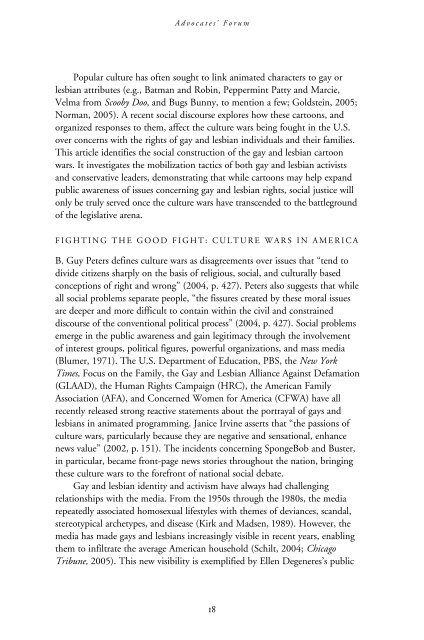2006 - School of Social Service Administration - University of Chicago
2006 - School of Social Service Administration - University of Chicago
2006 - School of Social Service Administration - University of Chicago
You also want an ePaper? Increase the reach of your titles
YUMPU automatically turns print PDFs into web optimized ePapers that Google loves.
Advocates’ Forum<br />
Popular culture has <strong>of</strong>ten sought to link animated characters to gay or<br />
lesbian attributes (e.g., Batman and Robin, Peppermint Patty and Marcie,<br />
Velma from Scooby Doo, and Bugs Bunny, to mention a few; Goldstein, 2005;<br />
Norman, 2005). A recent social discourse explores how these cartoons, and<br />
organized responses to them, affect the culture wars being fought in the U.S.<br />
over concerns with the rights <strong>of</strong> gay and lesbian individuals and their families.<br />
This article identifies the social construction <strong>of</strong> the gay and lesbian cartoon<br />
wars. It investigates the mobilization tactics <strong>of</strong> both gay and lesbian activists<br />
and conservative leaders, demonstrating that while cartoons may help expand<br />
public awareness <strong>of</strong> issues concerning gay and lesbian rights, social justice will<br />
only be truly served once the culture wars have transcended to the battleground<br />
<strong>of</strong> the legislative arena.<br />
FIGHTING THE GOOD FIGHT: CULTURE WARS IN AMERICA<br />
B. Guy Peters defines culture wars as disagreements over issues that “tend to<br />
divide citizens sharply on the basis <strong>of</strong> religious, social, and culturally based<br />
conceptions <strong>of</strong> right and wrong” (2004, p. 427). Peters also suggests that while<br />
all social problems separate people, “the fissures created by these moral issues<br />
are deeper and more difficult to contain within the civil and constrained<br />
discourse <strong>of</strong> the conventional political process” (2004, p. 427). <strong>Social</strong> problems<br />
emerge in the public awareness and gain legitimacy through the involvement<br />
<strong>of</strong> interest groups, political figures, powerful organizations, and mass media<br />
(Blumer, 1971). The U.S. Department <strong>of</strong> Education, PBS, the New York<br />
Times, Focus on the Family, the Gay and Lesbian Alliance Against Defamation<br />
(GLAAD), the Human Rights Campaign (HRC), the American Family<br />
Association (AFA), and Concerned Women for America (CFWA) have all<br />
recently released strong reactive statements about the portrayal <strong>of</strong> gays and<br />
lesbians in animated programming. Janice Irvine asserts that “the passions <strong>of</strong><br />
culture wars, particularly because they are negative and sensational, enhance<br />
news value” (2002, p. 151). The incidents concerning SpongeBob and Buster,<br />
in particular, became front-page news stories throughout the nation, bringing<br />
these culture wars to the forefront <strong>of</strong> national social debate.<br />
Gay and lesbian identity and activism have always had challenging<br />
relationships with the media. From the 1950s through the 1980s, the media<br />
repeatedly associated homosexual lifestyles with themes <strong>of</strong> deviances, scandal,<br />
stereotypical archetypes, and disease (Kirk and Madsen, 1989). However, the<br />
media has made gays and lesbians increasingly visible in recent years, enabling<br />
them to infiltrate the average American household (Schilt, 2004; <strong>Chicago</strong><br />
Tribune, 2005). This new visibility is exemplified by Ellen Degeneres’s public<br />
18
















